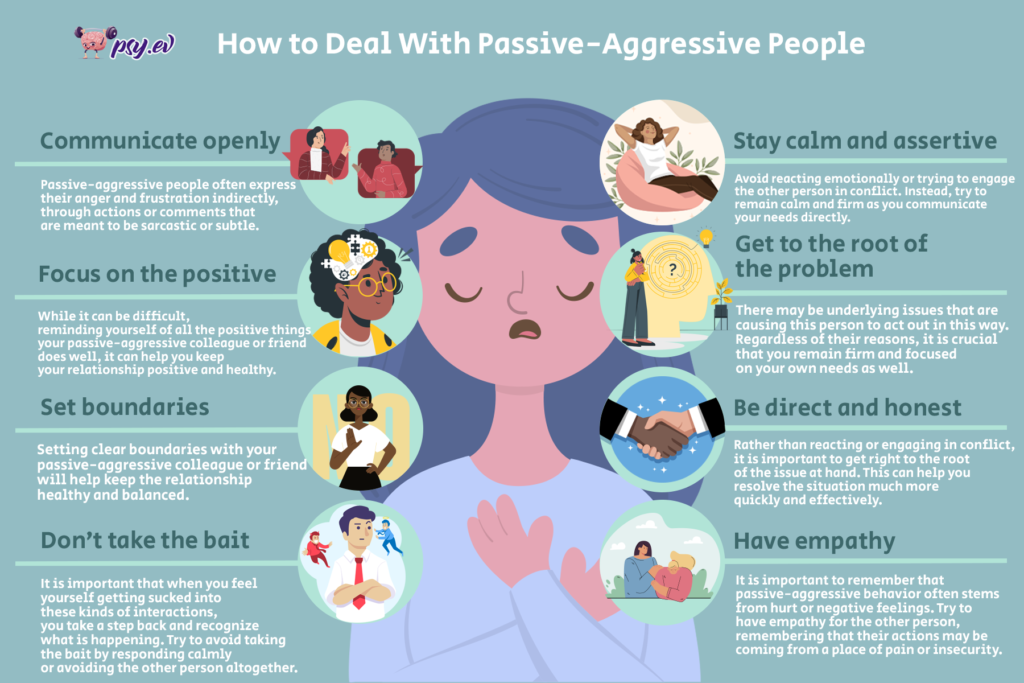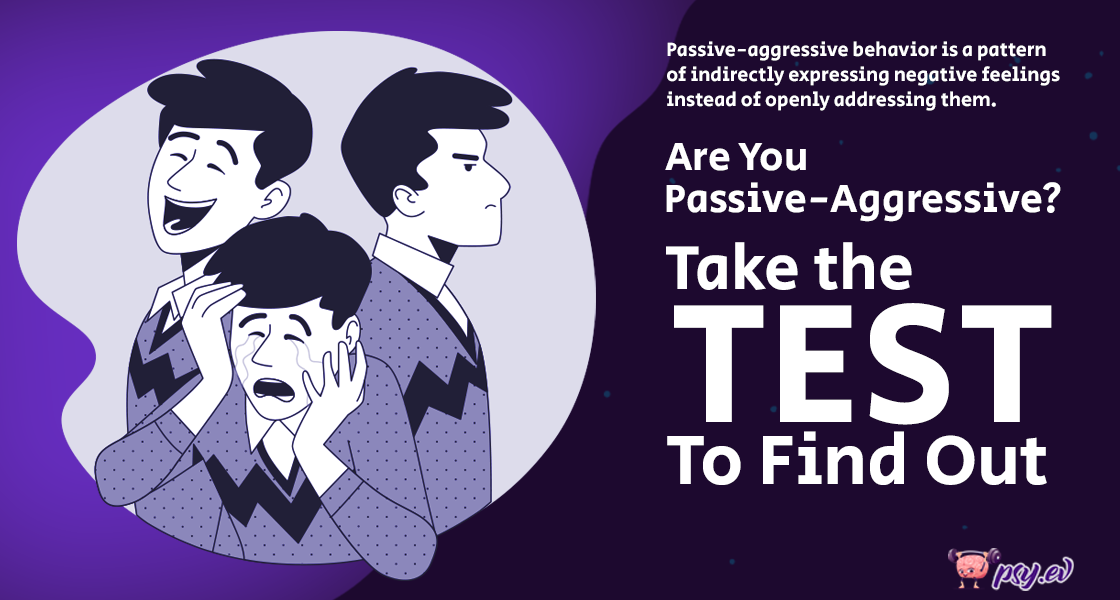Passive-aggressive behavior is usually described as another form of indirect communication, where the person expresses his feelings or negative intentions through actions instead of words. This type of behavior might seem to be effective, but it often causes resentment and hostility in others because they do not know how to address or deal with the hidden messages being sent to them. For example, a person might seem hostile or quiet when he is upset with his boss, causing the other people in the office to become uncomfortable and unsure of how to react.
What Does Passive-Aggressive Mean?
Passive-aggressive behavior can be described as a non-verbal aggression that manifests in negative behaviors. It’s a way of expressing hostility or resentment without openly admitting to it. Passive-aggressive behavior often occurs when someone feels they don’t have the power to directly express their anger or frustration.
15 Passive Aggressive Behavior Examples
- Sarcasm and subtle insults.
- Avoiding or delaying decisions or commitments.
- Sulking or withdrawing from conflict or confrontation.
- Making excuses and avoiding responsibility.
- Going along with things, even though you disagree or are unhappy about them.
- Resentful compliance or reluctant acquiescence.
- Using silent treatment to avoid conflict or confrontation.
- Playing the victim and blaming others for your problems or unhappiness.
- Sabotaging someone’s efforts, projects, or goals without their knowledge.
- Forgetting to do something you said you would do.
- Making promises or commitments that you have no intention of keeping.
- Engaging in passive-aggressive behaviors covertly, behind someone’s back, or under the guise of some other motive.
- Manipulating or pressuring others to do things you want, but don’t have the courage to ask directly for.
- Lying or making excuses instead of being honest and direct about your feelings or needs.
- Blaming others when things go wrong, rather than taking responsibility yourself.
Effects of Passive-Aggressive Behavior
Passive-aggressive behavior is not only ugly, but it can have a negative impact on both the person exhibiting this type of communication style as well as those around them. For instance, in some cases passive aggressive people feel frustrated due to their inability or unwillingness ever express what they really want without hints from others which often ends up causing more drama than necessary at work for example; while other times we see an individual who has been passively resisting everything including change himself becoming increasingly unhappy with his own life because he’s unable (or unwilling)to voice any feelings towards anything outside himself – leading him into depression wherein no one knows how much pain has been caused.
Passive-Aggressive Behavior Causes
The causes of this behavior are varied and complex. It can be influenced by individual factors such as personality type or environmental ones like family dynamics or work culture, but it’s also an understandable way for people who feel powerless in their lives to deal with difficult emotions like anger and resentment when they don’t have any other outlet available outside themselves which is healthy enough at least until we figure out how else this needs to be dealt w/ outside ourselves.
• Feeling of powerlessness or helplessness in dealing with a situation: People who feel like they have little control over their lives, whether due to living with an abusive parent or working at a job where they are constantly subjected to unreasonable demands, may use this type of behavior as a way to assert power or control in some situations.
• Coping with strong emotions such as anger or resentment: Rather than dealing directly with emotions that may be difficult to accept, like anger at the person who bullied them in high school, someone struggling with this type of behavior may instead act in a passive-aggressive manner. This can be healthy as long as the behavior is not used to cope with strong emotions at the expense of another person or their needs and wants.
• Family dynamics: a child who is constantly being criticized by their parent may learn that criticizing others is a way to deal with negative feelings. Similarly, if a child is constantly being criticized and ridiculed by their parents, they may develop the belief that they deserve to be treated poorly.
• Individual factor: being highly competitive or narrowly focused on one’s own needs. When someone acts in a passive-aggressive manner, it’s essential for them to take steps to understand and address the underlying issues that are leading them to this type of behavior.
Recognizing Passive-Aggressive Behavior
It is also possible that someone may have difficulty maintaining healthy boundaries and as a result, they may be more likely to act passive-aggressively.
While it’s easy to understand why people might resort to this type of behavior in certain situations, it can lead to significant problems when done on a consistent basis. It can create difficulties at work, cause problems with personal relationships, and damage self-esteem, in addition to making it difficult to properly address the very emotions that lead someone to behave passive-aggressively.
When someone acts in a passive-aggressive manner, it’s essential for them to take steps to understand and address the underlying issues that are leading them to this type of behavior. This can require therapy or other professional support, as well as taking time alone to get in touch with their emotions and find healthier ways to deal with them.
How to Deal With Passive-Aggressive People

Passive-aggressive behavior can be frustrating and harmful to both your personal and professional life. If you are dealing with a passive-aggressive person, it is important to understand what this behavior looks like in order to effectively address it. If you are dealing with a passive-aggressive person, there are several strategies that can be effective in changing their behavior.
1. Communicate openly.
People with this condition often express their anger and frustration indirectly, through actions or comments that are meant to be sarcastic or subtle. If you want your passive-aggressive colleague or friend to understand how their behavior makes you feel, it is important to communicate this openly and directly.
2. Focus on the positive.
Passive-aggressive people often express anger and resentment through belittling comments or sarcastic remarks. While it can be difficult, reminding yourself of all the positive things your passive-aggressive colleague or friend do well can help you keep your relationship positive and healthy.
3. Set boundaries.
Passive-aggressive behavior can be an attempt to manipulate and control others. Setting clear boundaries with your passive-aggressive colleague or friend will help keep the relationship healthy and balanced.
4. Don’t take the bait.
When you are dealing with passive-aggressive people, it can be easy to get into power struggles and escalations of conflict. It is important that when you feel yourself getting sucked into these kinds of interactions, you take a step back and recognize what is happening. Try to avoid taking the bait by responding calmly or avoiding the other person altogether.
5. Stay calm and assertive.
When dealing with a passive-aggressive person, it is important to stay calm and assertive. Avoid reacting emotionally or trying to engage the other person in conflict. Instead, try to remain calm and firm as you communicate your needs directly. This can help you address the issue at hand without triggering negative feelings or behaviors from the other person.
6. Get to the root of the problem.
It is also important to try and understand where the passive-aggressive behavior is coming from. There may be underlying issues that are causing this person to act out in this way. Regardless of their reasons, it is crucial that you remain firm and focused on your own needs as well.
7. Be direct and honest.
Another key strategy for dealing with passive-aggressive people is to be as direct and honest as possible. Rather than reacting or engaging in conflict, it is important to get right to the root of the issue at hand. This can help you resolve the situation much more quickly and effectively.
8. Have empathy for the passive-aggressive person.
It is important to remember that this behavior often stems from hurt or negative feelings. Try to have empathy for the other person, remembering that their actions may be coming from a place of pain or insecurity.
By showing compassion and understanding, you can help create a more positive relationship moving forward. Overall, dealing with passive-aggressive people can often seem frustrating and challenging. However, it is possible to maintain healthy boundaries, set limits, and create positive relationships with these individuals if you remain calm, assertive, and compassionate.
With these strategies in mind, you can successfully deal with passive-aggressive people and improve your relationships moving forward.
Passive-Aggressiveness Test
If you find that you are displaying passive-aggressive tendencies, don’t worry – help is available! There are plenty of resources available to help you change your behavior. So, please take this passive-aggressive test now and find out if you have this condition. After taking the quiz, feel free to visit our website for more information on how to deal with passive-aggressive people.


